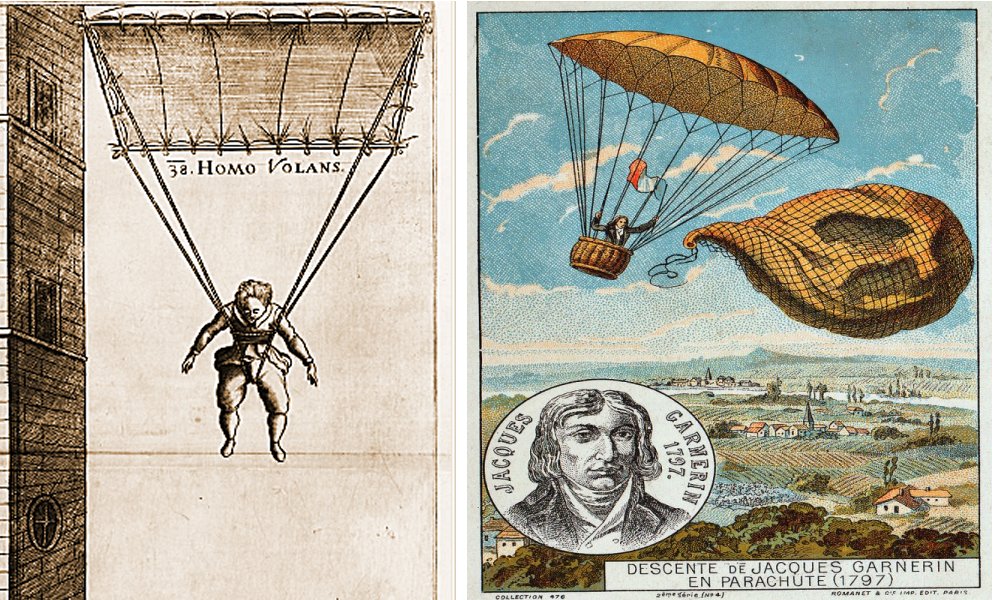Parachute May Have Been Invented By Ancient Chinese – Not Leonardo Da Vinci
Conny Waters - AncientPages.com - Leonardo Da Vinci is often credited with the invention of the first parachute. However, although he was a brilliant scientist, he did not invent the parachute. The history of parachutes can be traced to ancient China where we can find old references to the parachute-idea.
The earliest account of a parachute type of device was made some 4,000 years ago when the Chinese noticed that air resistance would slow a person's fall from a height.
In his book "Historical Records", the Western Han Dynasty writer Sima Qian mentions a legend which described how the emperor Shun nearly 2000 years before the Han Dynasty (4000 years past the present) use a sort of parachute to survive a fall.
According to the legend, Shun's father Gu Sou intended to kill him by forcing him to get on top of a roof and then burning him to death. Fortunately Shun held two large conical bamboo hats to escape from the roof and land on the ground safely. This is the principal of using bamboo hats to increase air resistance to reduce the falling speed.
As the eighth-century AD commentator Sima Zhen understood the idea of the parachute principle, he said that the hats acted like the great wings of a bird to make Shun’s body light and bring him safely to the ground.
Another, also extremely interesting reference we can find in the Ting Shi (Lacquer Table History) written by Yo Ke in 1214 AD. In this report, the grandson of the general Yo Fei describes what he saw in the foreign community of Arabs who lived in Canton, where his father was governor there.

Left: Fausto Veranzio's parachute design, titled Homo Volans ("Flying Man"), from his Machinae Novae ("New Contraptions", published in 1615 or 1616) via wikipedia; Right: Jacques Garnerin releases the balloon and descends with the help of a parachute, 1797. Illustration from the late 19th century.
He tells of a golden cock on the top of a pagoda; this lacked one leg, which had been stolen. The thief tried to sell the leg in the market and when questioned he explained how he had hidden in the pagoda and sawn it off.
Asked how he had been escaped, he replied:
“..I descended by holding on to two umbrellas without handles. After I jumped into the air, the high wind kept them fully open, making them like wings for me, so I reached the ground without injury..”
Then, later on in 200 B.C., there were acrobats performing stunts of great falls using something similar to parachutes during their acrobatics in the palaces of the early Han Emperors. Hence the invention of the parachute was for performances to entertain one emperor in China or to escape from another (murderous) emperor.
There are also historical accounts from 1308 indicating that again the acrobatics of the parachute activities appeared in the palace of the Yuan Emperor. In 1650 the parachute was being used in Siam (modern Thailand).
See also:
On This Day In History: Parachute Jump From 1,000 m Above Paris Is Recorded – On Oct 22, 1797
Did Leonardo Da Vinci Invent Contact Lenses In 1508?
The earliest evidence for the modern parachute dates back to the Renaissance period and the oldest parachute design is mentioned in an anonymous manuscript from 1470s.
Shortly after, a more sophisticated parachute was sketched by the polymath Leonardo da Vinci in his "Codex Atlanticus" (fol. 381v) dated to ca. 1485.
An old parachute design appears in an anonymous manuscript from 1470s Renaissance Italy. A more sophisticated parachute was later sketched by the Leonardo da Vinci in his Codex Atlanticus dated to ca. 1485.
Written by Conny Waters – AncientPages.com Staff Writer
Copyright © AncientPages.com All rights reserved. This material may not be published, broadcast, rewritten or redistributed in whole or part without the express written permission of AncientPages.com
More From Ancient Pages
-
 Re-Discovered Ancient Ksâr ‘Akil Fossils Shed New Light On Human Evolution
Archaeology | Mar 28, 2023
Re-Discovered Ancient Ksâr ‘Akil Fossils Shed New Light On Human Evolution
Archaeology | Mar 28, 2023 -
 Unique Wooden Stave Churches Were Built Without Nails – Remarkable Technology Helped Them Survive
Featured Stories | Nov 15, 2022
Unique Wooden Stave Churches Were Built Without Nails – Remarkable Technology Helped Them Survive
Featured Stories | Nov 15, 2022 -
 Controversial ‘Anomaly’ Discovered On Mount Ebal Could Be Biblical Joshua’s Altar
Biblical Mysteries | Apr 6, 2020
Controversial ‘Anomaly’ Discovered On Mount Ebal Could Be Biblical Joshua’s Altar
Biblical Mysteries | Apr 6, 2020 -
 Mystery Of The Unbreached Burial Chamber Inside A Little-Known Pyramid In The Dashur Complex
Featured Stories | Mar 18, 2022
Mystery Of The Unbreached Burial Chamber Inside A Little-Known Pyramid In The Dashur Complex
Featured Stories | Mar 18, 2022 -
 Rosicrucians’ Secret Knowledge Of Atlantis, Pyramids And Extraterrestrial Visitations
Ancient Mysteries | Apr 17, 2017
Rosicrucians’ Secret Knowledge Of Atlantis, Pyramids And Extraterrestrial Visitations
Ancient Mysteries | Apr 17, 2017 -
 Numa Pompilius – Remarkable Legendary Second King Of Ancient Rome Who Succeeded Romulus – Did He Ever Exist?
Featured Stories | Mar 2, 2018
Numa Pompilius – Remarkable Legendary Second King Of Ancient Rome Who Succeeded Romulus – Did He Ever Exist?
Featured Stories | Mar 2, 2018 -
 Were Owl-Shaped Plaques Children’s Toys In Copper Age?
Archaeology | Dec 1, 2022
Were Owl-Shaped Plaques Children’s Toys In Copper Age?
Archaeology | Dec 1, 2022 -
 Many Samurai Had Swords With Secret Crucifixes And Hidden Christian Symbols To Avoid Persecution
Ancient History Facts | Jan 10, 2017
Many Samurai Had Swords With Secret Crucifixes And Hidden Christian Symbols To Avoid Persecution
Ancient History Facts | Jan 10, 2017 -
 Why Does The Inner Ear Of Neanderthals Pose An Evolutionary Riddle?
Evolution | Feb 20, 2025
Why Does The Inner Ear Of Neanderthals Pose An Evolutionary Riddle?
Evolution | Feb 20, 2025 -
 Why Did Ancient Romans Cut Off Their Thumbs?
Ancient History Facts | Mar 2, 2020
Why Did Ancient Romans Cut Off Their Thumbs?
Ancient History Facts | Mar 2, 2020 -
 Tyrannical Tarquin The Proud: The Seventh And Last King Of Rome Was Banished
Featured Stories | Jan 28, 2020
Tyrannical Tarquin The Proud: The Seventh And Last King Of Rome Was Banished
Featured Stories | Jan 28, 2020 -
 Lost Knowledge Of Energy And Crystal Technology In Ancient Egypt
Ancient Mysteries | May 17, 2019
Lost Knowledge Of Energy And Crystal Technology In Ancient Egypt
Ancient Mysteries | May 17, 2019 -
 Bazira – Lost City Of Alexander The Great Discovered In Pakistan
Archaeology | May 7, 2019
Bazira – Lost City Of Alexander The Great Discovered In Pakistan
Archaeology | May 7, 2019 -
 Early Humans Used Fire To Make Stone Tool – New Study
Archaeology | Oct 16, 2020
Early Humans Used Fire To Make Stone Tool – New Study
Archaeology | Oct 16, 2020 -
 Taharqa – The Most Powerful Of The Black Pharaohs
Featured Stories | Jan 29, 2016
Taharqa – The Most Powerful Of The Black Pharaohs
Featured Stories | Jan 29, 2016 -
 2,500-Year-Old Tibetan Medical Text Describes A Coronavirus-Like Outbreak In Surprisingly Accurate Details
News | Oct 26, 2020
2,500-Year-Old Tibetan Medical Text Describes A Coronavirus-Like Outbreak In Surprisingly Accurate Details
News | Oct 26, 2020 -
 How Did A Roman Sarcophagus End Up On A Beach Near Varna In Bulgaria?
Archaeology | Aug 6, 2024
How Did A Roman Sarcophagus End Up On A Beach Near Varna In Bulgaria?
Archaeology | Aug 6, 2024 -
 On This Day In History: Spanish Conquistadors Led By Hernan Cortés Entered The Aztecs Capital Tenochtitlán – On Nov 8, 1519
News | Nov 8, 2016
On This Day In History: Spanish Conquistadors Led By Hernan Cortés Entered The Aztecs Capital Tenochtitlán – On Nov 8, 1519
News | Nov 8, 2016 -
 Uraeus – Sacred Emblem That Symbolized Sovereignty, Royalty, Deity And Divine Authority In The Land Of Pharaohs
Featured Stories | May 30, 2022
Uraeus – Sacred Emblem That Symbolized Sovereignty, Royalty, Deity And Divine Authority In The Land Of Pharaohs
Featured Stories | May 30, 2022 -
 Fragments Of 100 Viking Swords Unearthed In North Estonia – Largest Find To Date
Archaeology | Oct 6, 2019
Fragments Of 100 Viking Swords Unearthed In North Estonia – Largest Find To Date
Archaeology | Oct 6, 2019

